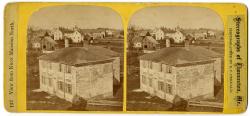(Page 3 of 6) Print Version
Peace and Beginning of Prosperity
In 1778 the Continental Congress divided Massachusetts into three maritime districts, including the District of Maine, and the original counties of York, Cumberland, and Lincoln carved off Hancock and Washington (1789), Kennebec (1799), Oxford (1805), Somerset (1809), and Penobscot (1816). Between 1784 and 1800 Maine's population swelled from 56,000 to over 151,000.
Falmouth – Portland after l786 – recovered quickly from the disaster of 1775 and grew to become Maine's major seaport. The mainstay of its economy was a thriving trade in wood products, livestock, fish, house frames, and produce with the West Indies in return for molasses, sugar, and rum. Portland also built small brigs, sloops, and schooners for the West Indies trade and shipped produce coming down from the interior highlands of Maine, Vermont, and New Hampshire.
Prosperity fostered a complex society, with merchants, doctors, lawyers, shopkeepers, and clergy at the apex; artisans and small shop owners in the middle; and sailors, laborers, servants, and slaves at the bottom. The classical motif in the new federal-style mansions back from the waterfront reflected the aristocratic aspirations of the rising merchant class, as well as their celebration of America's emerging democratic ideals.
Back-country society was much more leveled, although growing resentment toward land speculators, merchants, and money-lenders kept the frontier restive. The interior towns offered cheap land – a magnet for poor farm families from central New England – and the small vessels that plied the coastal waters carrying country goods to Boston provided cheap transport for the aspiring pioneers.
But isolation kept many farms at subsistence levels, since wood, grains, and orchard crops were too bulky to transport over rough roads, and the thin soils, unpredictable winters, predators, droughts, and pest infestations kept even the most modest goals in doubt.
Farmers spent summers in "watchful anxiety," aware that any of a number of misfortunes could mean near starvation over winter for family or livestock. Even in good times they lived on a monotonous diet of rye-and-corn bread, beans, fish, game, milk, rum, pudding, barley cake, pork, beef, and potatoes.
Inland towns were scattered broadly along a river or road, since arable land was unevenly distributed and mills were anchored to dispersed waterpower sites. Gradually, town activities were drawn to a central waterpower site, and as millwrights gained economic footing, they added to their enterprise some combination of general store, public house, warehouse, distillery, foundry, blacksmith shop, carding and fulling mill, spinning factory, or gristmill.
Given these vital functions, the nascent town centers became gathering-places for neighbors, who drank, debated, and socialized while they conducted business.
Commercial exchanges quickened, and these small nodes of activity attracted shoemakers, tailors, blacksmiths, doctors, lawyers, and ministers. Through these town centers, farmers funneled a trade in staves, shingles, clapboards, and produce. Farmwomen spun yarn or wove cloth from wool, flax, or imported cotton, also in connection with centrally located merchants.
Taking advantage of this massive migration to the interior, proprietors holding the old colonial Pejepscot, Waldo, Clarke and Lake, and Plymouth patents reasserted their claims to these lands. Being desperately in debt after the Revolution, Massachusetts sold other lands to well-connected merchants to pay off its obligations.
The most conspicuous beneficiary of this policy was former Revolutionary War general Henry Knox, who between 1791 and 1794 gained control of 3.5 million acres in the Kennebec and Penobscot valleys, including some lands already settled. An obsessive speculator, Knox launched a dizzying array of business ventures from his palatial mansion in Thomaston, including farms, barrelworks, brickworks, sawmills, gristmills, lime kilns, and shipping and fishing facilities.
Proprietors like Knox assumed that the frontier was a place of chaos, where men escaped the discipline of hard work and lived by poaching timber, fish, furs, and game.
Friendly URL: https://www.mainememory.net/exhibits/statehoodoverview









